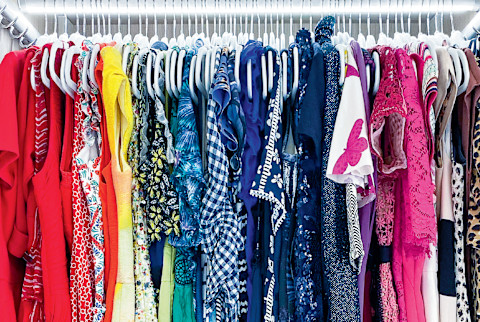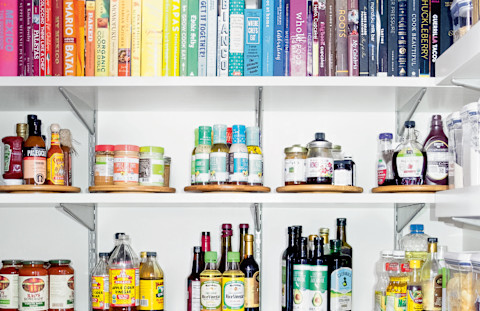Organization vs. Minimalism: Why "Less" Isn't The Answer for Everybody

Now, perhaps more than ever, keeping an organized home is a meaningful act of self-care, key to our overall well-being...and sanity. In The Home Edit Life: The No-Guilt Guide to Owning What You Want and Organizing Everything, experts Clea Shearer and Joanna Teplin (the stars of the Netflix series Get Organized With the Home Edit) will help you transform your home and mindset, making every day just a little easier and more beautiful. As they explain, organizing isn't about changing who you are, getting rid of meaningful belongings, or casting things aside; it's about finding solutions that accommodate YOU and the way you live—in a way that doesn't look like anyone else. Organizing doesn't have to mean LESS; it's about efficiency and creating homes within your home for the many things your unique life requires.
For tips that are equal parts functional, aesthetic, and therapeutic, read and get inspired by the excerpt below before buying your own copy here.

We promise we're not trying to take away your organizing fun, but we do want to reiterate that starting small and working your way up is the best way to ensure a successfully organized space. Starting on a drawer might seem like an insignificant project, but it can be just as transformative as organizing a larger space (and what is better than an organized bathroom drawer?), helping to eliminate common hassles and improve your everyday life. In other words, no more rummaging around for a hair tie or trying to find a pen to sign a permission slip. Have we sold you on starting small yet?
Rebranding the no-junk drawer.
So what if a drawer holds random items? As long as everything is contained and categorized and makes sense in your daily routine, that's all that matters. Organization isn't one-size-fits-all, and customizing spaces to your needs is the golden ticket.
In the same way that we don't want you to feel guilty about using dry shampoo for the fifth day in a row, we also don't want you to feel guilty when it comes to editing your items. After all, you should fill your home with only the things you like, need, or find sentimental. Here are a few examples.
Things you might like:
- Candles
- Clothing
- Framed photos
- Guitars
- Jewelry
- Vases
Things you might need:
- Batteries
- Documents
- Hand soap
- Light bulbs
- Tax returns
- Toilet plunger
Things you might find sentimental:
- Childhood items
- Family heirlooms
- Kids' artwork
- Notes and cards
- Old photos
- Wedding dress
An incomplete list of things you think you need but 99% of the time do not:
1. Pumpkin puree that will expire before next Thanksgiving (you didn't make that pie last year, either!)
2. Same goes for those cans of condensed milk
3. Souvenir cups from theme parks (that's what photos are for—your old soda cup is not a memory)
4. Anything that's missing a part (you are probably not going to a repair store to fix your blender—just get a new one you will use)
5. Every vase that has ever arrived with a floral delivery
When assessing whether to keep a particular item, put yourself to the test and consider which bucket it might fall into. If you can safely say that YES, you like it (maybe you haven't worn it recently, but this is your reminder to put that sweater into the rotation), or YES, you still need to hold on to it (hey, we all need toilet plungers), or YES, it's special to you (your child put some extra thought into that rock they painted for Mother's Day)—then by our measure, it can stay. Which brings us to our next point about the No-Guilt Life...
IT'S OK TO OWN THINGS. ONCE MORE FOR THE PEOPLE IN THE BACK!
IT'S. OK. TO. OWN. THINGS.
We are so proud of everyone's efforts to declutter their homes. It's a critical piece of the organizing process. Once you edit your items, what's left are the items that matter to you (that plunger might even matter one day!). And so you should feel absolutely no guilt about owning the items that comprise your life. Why fight the fact that your newborn needs a closet full of diapers, or your teenager needs a closet full of sports equipment? Resisting your reality instead of embracing it is unproductive and ultimately not useful. You're better off spending your time and energy looking for an organizing solution that accommodates all the components of your life rather than trying to live like someone else.

Organization versus minimalism.
Organization is often conflated with minimalism, when, in fact, they are two very different things. You might define minimalism as living with less, while organization is an efficient and orderly arrangement of things or tasks. Minimalism is a design style and a lifestyle choice. But to be organized does not mean you must inherently own fewer things. It just means you need to be thoughtful about what you do own. You need to treat your things and your space with equal respect. An article once described us as "the organizing pros who let you keep more stuff." It made us laugh, but it also rang true. We want to help people live within their boundaries rather than make them throw everything out. Because you can't own everything, but you can own plenty of things. Plus, if you mindlessly throw everything out, then you risk having to replace some of those things that you really did need, which is more wasteful than finding an appropriate solution for accommodating how you really live.

The Golden Rule: 80/20
One of our core beliefs is that you get the item or you get the space, but you don't get both. Everything you own takes up a certain amount of physical space, and eventually, even the largest home will run out of square footage. So how do you avoid that doomsday scenario? By making sure you live by our 80/20 philosophy: Keep your home no more than 80% full, and reserve at least 20% for breathing room. Using all the available space in your home is a bit like eating until you are overly full. It's as uncomfortable for your belt buckle as it is for your closets. And what if you want dessert? Or an extra pair of shoes? When you have no breathing room, you have no options, and that's just no way to live.
Top 5 tips to avoid running out of space:
1. Never buy more hangers! You get what you get, and you don't get upset.
2. Contain everything so you know when you've exceeded your designated space.
3. With every new purchase, ask yourself, "Where is this going to live?" If you don't have an answer, it doesn't go home with you.
4. Set aside time once or twice a year to revisit and edit your spaces.
5. Wear a shock collar that physically stops you from leaving the house and buying more items.
As you begin to approach the 80% threshold, you'll notice things don't fit like they used to: You start cramming things into drawers, fighting with your pantry, and secretly wondering if you can store your winter coats in your daughter's closet. None of these things feels good, and it quickly becomes a puzzle too frustrating to solve. And that's what we're here for! We can help you solve your space while still embracing all the things you need, want, or use in your life. Whether you have it because you have kids, or you use it for work, or it simply makes you happy to look at—you get our official green light and approval to own said item. As long as you can store it appropriately without encroaching on the rest of your home, we see no reason to live with less if that doesn't work for you.
